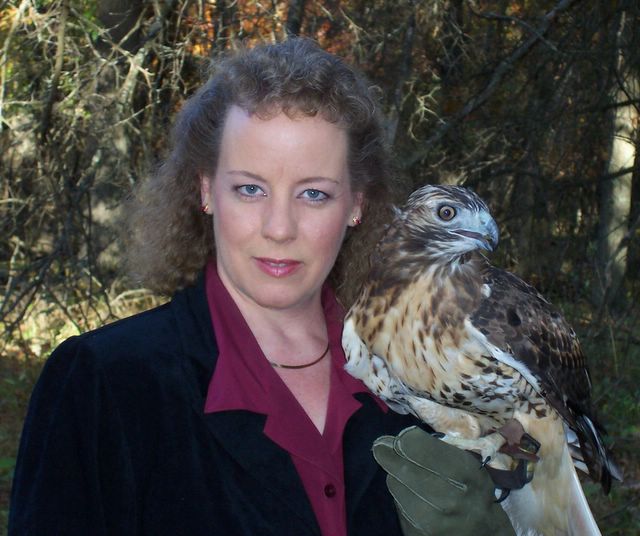El Huayco
 "I'm a lookin at YOU!!" Replies this monstrous Harpy Eagle.
"I'm a lookin at YOU!!" Replies this monstrous Harpy Eagle. Cassini Peregrine Falcon
Cassini Peregrine Falcon(These birds are bred for falconry)
Everywhere that falconry is practiced, there is a native falcon to fill that nitch. Or rather, wherever there are falcons to be found, humans have longed for a relationship with these exquisite creatures. The Peregrine falcon is one of the most wide spread of raptors, with sub-species found throughout the world, and on every continent except Antarctica. The Cassini subspecies of this extensive family is the Peregrine of the Andes.
El Huayco has 100 mews, the name falconers use for a raptor's enclosure, many which provide paired birds with quiet privacy for breeding and raising their young. However, some of these mews are devoted to housing native species who for one reason or another cannot be returned to the jungles or deserts.  Black and White Hawk Eagle
Black and White Hawk Eagle Black Chested Buzzard Eagle
Black Chested Buzzard Eagle
Some birds, such as the one above, are housed with several birds of their kind, waiting for the opportunity when they will regain their freedom. This guy was incredibly curious about me, and fidgeted and footed his perch, twisting his head around. If the bars of his mews were not in the way, I'm pretty sure I would have had this bird bouncing off my head! Bat Falcon
Bat Falcon
(These birds are bred for falconry)
You cannot get a sense of the perspective of this little falcon above, but it is a diminuative hunter, a little larger than a Merlin, named for the quarry of choice for this species . . . bats!
Of all the birds at the facility, and with Jose's warning to be careful at the bars, this was the only bird that flew at me trying to grab at me. In history it is the king of the Peruvian raptors, a messenger between the gods and men. She was just insisting on my respect, this female displaying here, clicking her warning with her beak prior to launching at me!
 White Hawk
White HawkThe multiple hallways of mews circle around a central courtyard, a common structure in many Central and South American homes and buildings. The tropical sun does not waver much throughout the year, so the area around Lima, and much of Peru for that matter, does not have seasons like fall and winter, but rather a continual variety of summer separated into rainy and dry seasons. The grass in the courtyard grows thick and lush. There are several large enclosures with an incredible number of birds tied to their block perches. The inner courtyards also have many bow perches with birds tethered out, soaking up the noon-day sunshine peeking through the shade of the overhanging trees. Jose applogized to me that many of his birds were moulting, and were not in the peak of feather condition. I didn't notice, so very fascinated I was to see such a wide variety of species all in one location.
 Ornate Hawk Eagle
Ornate Hawk EagleI really liked the look of this bird! I have never seen a raptor that I did not find to be pleasing to the eye, but the particular patterns and colors to be found on this creature seem to come together in such a dramatic way.
 Harpy Eagle
Harpy Eagle








4 Comments:
At 2:22 AM, Christopher Jimenez said…
Christopher Jimenez said…
Very sad to see Harpys, Spizaetus, Black Hawk Eagles, etc TRAP LIKE THIS!!!.
I highly doubt that these animals where breed in captivity
At 6:40 PM, Carolyn said…
Carolyn said…
I'll reply to this comment here, as the poster did not include any way to respond direct. I can understand there are those with the opinion that we should not touch or interfere with wildlife at all. As a falconer myself, partaking in a centuries-old practice and art form, I cannot disagree more. Certainly, trapping and caging and smuggling birds to a market for the highest price . . . THAT is a crime against nature. Carefully managing birds that were rescued from just such a fate, rehabilitating them, and returning to the wild those that can, I fully support . . . and that is one of the missions of El Huayco. People are free to judge for themselves, but I was there, I saw the facility, I saw the excellent condition the birds were held in, I saw the breeding pairs, and I saw some of the young that have been produced. If the sole purpose was to trap wild birds, and ship them off for sale as soon as possible, they would not have been as well cared for. El Huayco was one of the cleanest, least chaotic places I visited while in Peru, which is a country filled with noisy cities, an incredible number of stray and starving dogs, and overworked oxen and mules. I'm inclined to believe it was as I observed it . . . an excellent facility for rescue, rehabilitation, and breeding of certain species for falconry.
At 10:17 AM, Anonymous said…
Anonymous said…
These birds were rescues ! They wouldn't be alive if they weren't brought there and rehabilitated!
At 8:39 PM, Anonymous said…
Anonymous said…
Sad to read somebody like Christopher, he should go and see the facilities to believe. It´s being along time ago since birds of prey are being produced in captivity and in enough numbers. Breeders from all the world have found that removing the clutches duplicate and triplicate the production of youngs, some pairs here have produced up to four clutches in a year. The Huayco has pionered in breeding some raptor species first time in the world, ever. I believe that Christpher writes in part due to his ignorance in the point, the other half is he hates people that does things beyond his capabilities and understanding
Post a Comment
<< Home